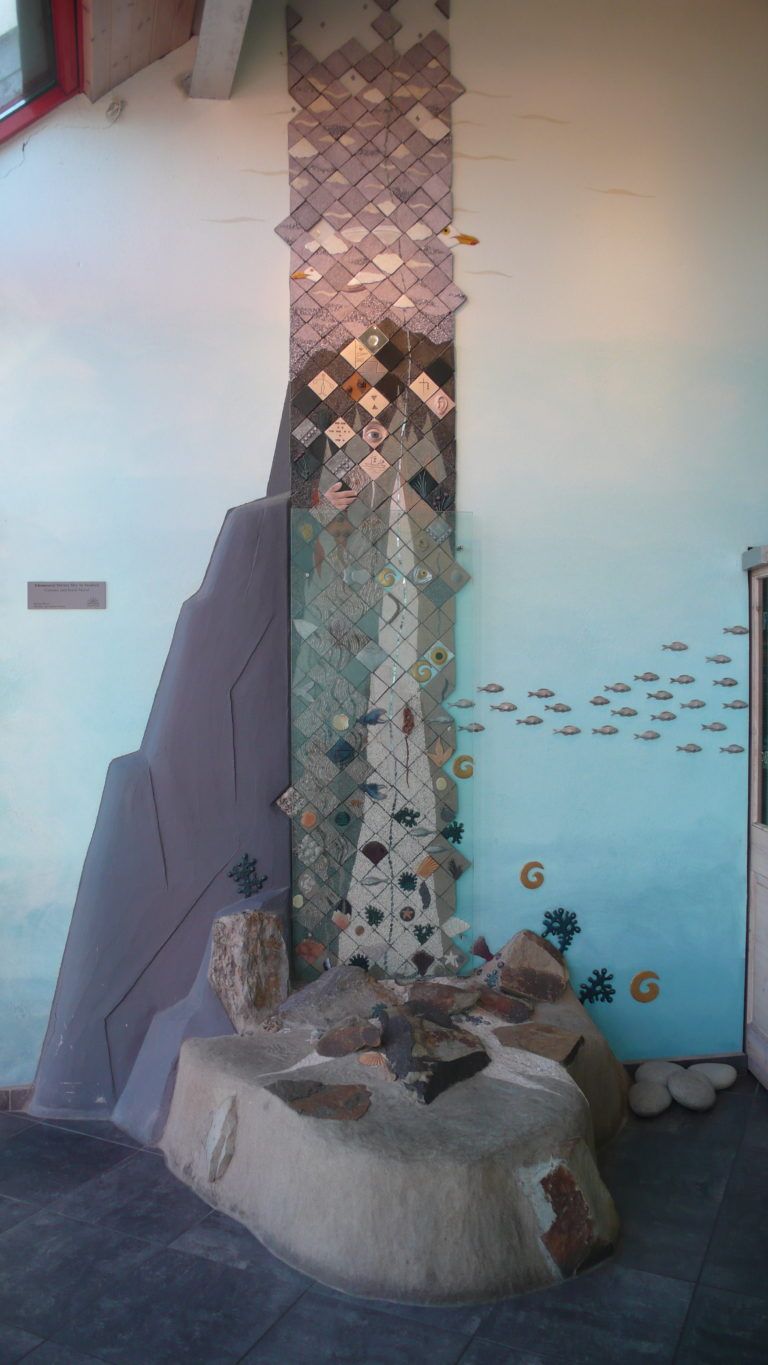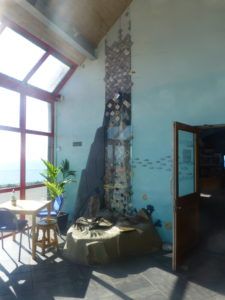
“Elemental Stratum.” Sky to Seabed mural.
 This is a mixed media mural depicting a segment of life on the tip of The Mizen peninsula, from the sky to the bottom of the sea, like a textbook geological stratum. It has all been executed in clay, crushed local rocks and shells. There is however one real shell. Can you find it? The “elements” can mean the components of The Mizen, or the “elements” can mean the weather. How many elements can you see? What does the Morse code or the semaphore say? Some of the sky level elements are: clouds, sea gulls, feathers, mist.
This is a mixed media mural depicting a segment of life on the tip of The Mizen peninsula, from the sky to the bottom of the sea, like a textbook geological stratum. It has all been executed in clay, crushed local rocks and shells. There is however one real shell. Can you find it? The “elements” can mean the components of The Mizen, or the “elements” can mean the weather. How many elements can you see? What does the Morse code or the semaphore say? Some of the sky level elements are: clouds, sea gulls, feathers, mist.
Some land elements: Morse code and semaphore, lens, reinforced metal, lichens, thrift and fern, seeping rust and of course the human element, coping with the elements. Some sea elements: coiled Tube worms, Sand star, sea urchins, Great Scallop, seaweed, lobster, Beadlet Anemone. A seabed cable to convey messages from the lighthouse to the coast. Despite the many varied colours in the mural they have all come from locally derived oxides and natural pigments. We ground and sifted several samples of stone and shells. Our young daughters, Kloe and Eliza, were useful helpers at this stage. The sand came from Barleycove Beach, crushed cockles from Cockle Beach and crushed mussels from Mussel Beach, which give the sky section its misty blue colour. The green colour at the land level of the sculpture comes from crushing green sandstone, which has a green coloured mineral called chlorite. That also gave the sea level its green tinges in the glaze. All the rocks on the Mizen peninsula belong to the Old Red Sandstone, which is made up of alternating layers of purple, green and sometimes grey rock. These layers can be slate, silt stone or sandstone. They throw up an array of colours and oxides. The layers are what geologists call beds. They are hardened remains of those sediments, which were originally deposited as horizontal strata in ancient rivers or ancient lakes. The glittering on the rocks at the bottom of the mural comes from quartz. The red colours are from purple Siltstone, which contains hematite, an iron oxide. This also “rusted” the ceramic bolts.

July and August
Daily 10am-6pm
September, October
April, May, June
Daily 10.30am -5pm
November - March
Weekends 11am-4pm
Adult: €7.50 | Senior/Student: €6
Child under 14: €4.50 | Child under 5: Free
Group & Family Deals
Family (2 Adults and up to 4 Children): €25
Groups (10 and over): Adults: €6.50 | Senior/Student: €5 | Child 5-14: €3.50

